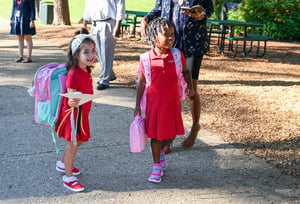Building foundational math skills in preschool.
Written in Collaboration with Susie Welty, Preschool Teacher
It's another fun day of learning in Congressional's preschool classes, and the students are eager to begin their next activity. They are going to prepare a gift for their parents – oatmeal chocolate chip cookie mix - that they will scoop into a plastic bag, secure with a twisty tie, and place into a gift bag to take home. What the students don't realize is that behind this fun activity is a math lesson.
 |
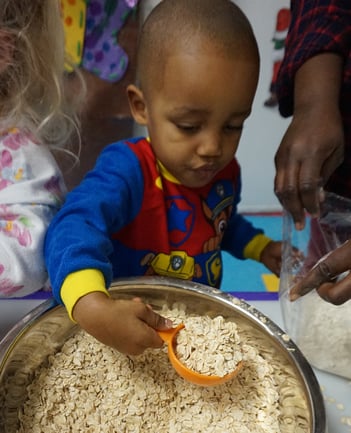 |
After washing their hands, the students approach the activity station one-by-one. With guidance from their teacher, they move to the first stop on the multi-step activity. In front of a bowl filled with flour is a sign on which is written a large number 4. The teacher asks them to read the number, count out that number of scoops and level them off before pouring the ingredient into a bag. The next step calls for 3 scoops of brown sugar. The consistency of the sugar is lumpier than the flour, requiring a different approach by the students to level the measuring scoop before placing the sugar in the bag. Visibly enjoying the activity, the students read each numbered sign and count out loud as they scoop - one, two, three... They continue down the row, reading the signs, scooping the ingredients and placing them carefully into the bag.
"Learning in preschool centers on organized, play-based activities that provide context for what the students are learning. When they make a connection to what they learn, it becomes meaningful to them."
Susie Welty, Preschool Teacher

"Preschool math focuses on the numbers 0-10," states Susie Welty, Preschool Teacher. "But we don’t want students to just memorize these numbers, we want them to have a deep understanding of them." An effective teaching tool in preschool math is the ten frame. It is a graphic tool used to help students comprehend number recognition and value for numbers 0-10. Concepts become more apparent to students when presented linearly and the ten frame helps to establish an important foundation for working with more complex numbers.
“We might have the students count objects, or create groups based on similarities of color, size, and shape. We may have them sort items and gather them in groups of 10,” says Susie. We can do this in the classroom with manipulatives or outside using natural items like twigs and pebbles. We also work on recognizing a number of items without actually counting them. This is called subitizing. Just as one might see the dots on a dice and know immediately the number, the students learn to quickly recognize groupings of small amounts of objects.”
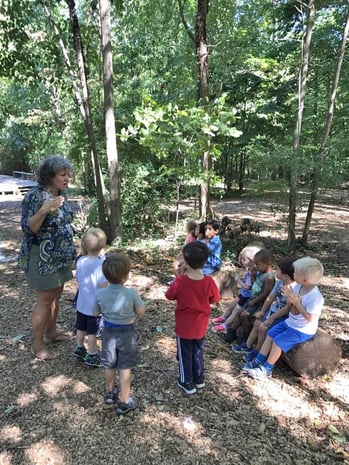 |
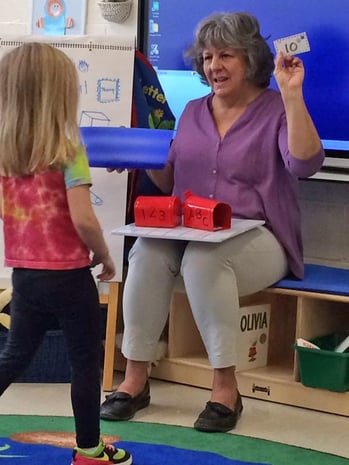 |
Small, group-based activities provide teachers with opportunities to observe students and work with them one-on-one. “It is important that each student demonstrates a full understanding of the concept”, states Susie. “If they get it, if they can demonstrate to us that they can connect with the concept, we know they are ready to move on."
How do the teachers know whether a student has grasped the concept and is ready to move on? “Learning is done through teacher-directed activities and independent student exploration,” says Susie. “Students work in small groups and start by watching the teacher model the activity to help reinforce the concept. The students then work independently as the teacher observes and offers encouragement. If a student needs additional assistance, the teacher is there to provide it. The teacher can also see when a student completes an activity with ease and is ready to offer additional challenges to keep the student engaged and moving forward."

In lessons such as the oatmeal, chocolate chip cookie activity, more math-based concepts are at play than may meet the eye. “Learning activities such as these create opportunities for students to use mathematical terminology,” says Susie. “For example, students may spend time at the sensory table, pouring sand or water into measuring cups. They may be tasked with counting how many times they fill the bucket with sand. They may work on volume, balance, estimating and measurement, or they may fill containers and compare and contrast. These are concepts they will build on throughout their education that are just coming into focus in preschool. It is our job to help reinforce them."
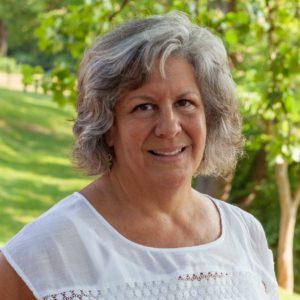
Featured:
Susie Welty
Preschool Teacher



